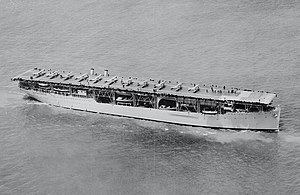
Back USS Langley (CV-1) Afrikaans Ленгли (CV-1) Bulgarian USS Langley (CV-1) Czech USS Langley (CV-1) German USS Langley (CV-1) Spanish یواساس لانگلی (سیوی-۱) Persian USS Langley (CV-1) Finnish USS Langley (CV-1) French USS Langley (CV-1) Croatian USS Langley (CV-1) ID
 USS Langley underway, 1927
| |
| History | |
|---|---|
| Name |
|
| Namesake | |
| Builder | Mare Island Naval Shipyard |
| Laid down | 18 October 1911 |
| Launched | 24 August 1912 |
| Commissioned | 7 April 1913 |
| Decommissioned | 24 March 1920 |
| Recommissioned | 20 March 1922 |
| Decommissioned | 25 October 1936 |
| Recommissioned | 21 April 1937 |
| Renamed | Langley, 21 April 1920 |
| Reclassified |
|
| Stricken | 8 May 1942 |
| Identification |
|
| Nickname(s) | "Covered Wagon" |
| Honors and awards |
|
| Fate | Scuttled after Japanese air attack off Java coast, 27 February 1942; 8°51′4″S 109°2′3″E / 8.85111°S 109.03417°E |
| Badge |  |
| Class overview | |
| Preceded by | N/A |
| Succeeded by | Lexington class |
| Planned | 2[1] |
| Completed | 1 |
| General characteristics | |
| Class and type |
|
| Displacement | |
| Length | 542 ft (165.2 m)[2] |
| Beam | 65 ft 5 in (19.9 m)[2] |
| Draft |
|
| Installed power | |
| Propulsion |
|
| Speed | 15.5 knots (28.7 km/h; 17.8 mph) |
| Range | 3,500 nmi (6,500 km; 4,000 mi) at 10 knots (19 km/h; 12 mph)[2] |
| Complement |
|
| Armament |
|
| Aircraft carried |
|
| Aviation facilities |
|
USS Langley (CV-1/AV-3) was the United States Navy's first aircraft carrier, converted in 1920 from the collier USS Jupiter (Navy Fleet Collier No. 3), and also the US Navy's first turbo-electric-powered ship. Conversion of another collier was planned but canceled when the Washington Naval Treaty required the cancellation of the partially built Lexington-class battlecruisers Lexington and Saratoga, freeing up their hulls for conversion to the aircraft carriers Lexington and Saratoga. Langley was named after Samuel Langley, an American aviation pioneer. Following another conversion to a seaplane tender, Langley fought in World War II. On 27 February 1942, while ferrying a cargo of USAAF P-40s to Java, she was attacked by nine twin-engine Japanese bombers[4] of the Japanese 21st and 23rd naval air flotillas[2] and so badly damaged that she had to be scuttled by her escorts. She was also the only carrier of her class.
- ^ "H-069-1: "The Covered Wagon": USS Langley (CV-1)". Archived from the original on 3 June 2022. Retrieved 3 June 2022.
- ^ a b c d e f g h i Ford et al. 2001, p. 330
- ^ Messimer, Dwight (1983). Pawns of War: The Loss of the USS Langley and the USS Pecos. Annapolis, MD: United States Naval Institute.
- ^ USN 2009.
© MMXXIII Rich X Search. We shall prevail. All rights reserved. Rich X Search